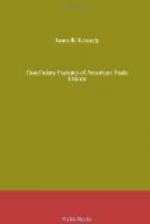The system in operation at present provides that members in good standing who have been on the unemployed list for eighteen days shall be entitled to six dollars per week. After drawing twenty-four dollars, no further benefit is granted until the member is on the unemployed list again for eighteen days, and no member is entitled to more than ninety-six dollars in any one fiscal year. Since 1888, with the exception of the fiscal years ending June 30, 1890, and June 30, 1891, the amount paid for out-of-work assistance has been the largest single item in the budget of the Union. During the year ending June 30, 1894, $17,262.50, or $14.33 per capita, an equivalent of forty-eight per cent. of the total disbursements for all benevolent purposes, was paid in out-of-work claims. The total amount paid up to June 30, 1906, was $145,826.91, and the average yearly per capita cost had been $5.99.[166]
[Footnote 166: See table, page 91.]
Only two other American unions paid out-of-work benefits in 1906. Both of these are small unions and recently organized. The National Brotherhood of Coal Hoisting Engineers pay five dollars per week to members out of employment, after the first thirty days, until work is secured, or until the expiration of twelve weeks.[167] The Jewelry Workers provide for the payment of seven dollars per week to married men and five dollars to unmarried men.[168] Certain other unions, notably the Pattern Makers,[169] pay a “victimized” benefit to members who are unable to secure employment because they are members of the union. Such benefits are directly connected with collective bargaining, and any discussion thereof lies without the scope of this monograph.
[Footnote 167: Constitution, 1902 (Danville, Ill., n.d.), p. 14.]
[Footnote 168: Constitution, 1902 (New York, n.d.), p. 6.]
[Footnote 169: Constitution, 1906 (New York, n.d.), p. 17.]
The introduction of a national out-of-work benefit has been, however, much discussed in several important unions. These have been the International Typographical Union, the Brotherhood of Carpenters and the Boot and Shoe Workers’ Union. The unemployment caused by the depression of 1892-1897 was responsible for much of the consideration given the matter.
In none of these unions has the subject been more fully debated than in the Typographical Union. In October, 1895, the New York local union adopted an out-of-work benefit, which provided for its unemployed members an allowance of four dollars per week for a period of eight weeks in each year.[170] Such activity on the part of the largest local union added considerable force to the movement for an International benefit. President Prescott in his report to the forty-second session of the International Union in 1894 recommended the establishment of an out-of-work benefit, in preference to a sick benefit. He showed that during 1894 several of the largest local unions had found it necessary




